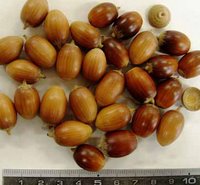
Eating is living.
In modern Japanese society, there are too much food. We can choose what we eat or avoid freely.
You have likes and dislikes of food, don't you?
What did ancient people, for example, Palaeolithic and Jomon people eat? Could they choose food?
Generally speaking, before rice cultivation, people got food by hunting,
fishing, and gathering plants.
Which kind of animals and fish/shellfish did ancient people eat?
We can assume these from animal bones, fish bones, and shell remains.
HOWEVER
Which kind of plants did people eat?
This question is very difficut to answer.
Why is this problem difficult to approach?
Plants with hard nutshell (e.g. acorn, nut) can be preserved in the sediments.
But rhizomes, tubers, and corms such as yama-imo (yam) and
warabi (bracken fern) are easily decayed, and then, they cannot be preserved.
We don't know whether these plants were eaten or not.
In other words, we cannot approach to food history by plant macroremains
found from archaeological sites.
How can we solve this problem?
From next articles, I will offer some approaches with recent Japanese
archaeological research projects.
Comments
Post a Comment